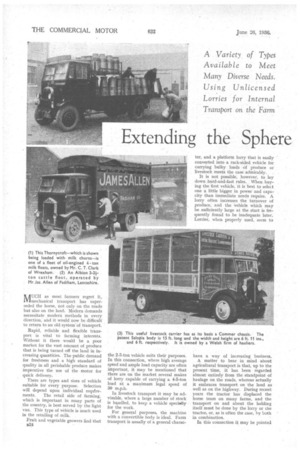Extending the Sphere of the Farm Vehicle
Page 66

Page 67

If you've noticed an error in this article please click here to report it so we can fix it.
A LTG; as most farmers regret it, almechanical transport has superseded the horse, not only on the roads but also on the land. Modern demands necessitate modern methods in every direction, and it would now be difficult to return to an old system of transport.
Rapid, reliable and flexible transport is vital to farming interests. Without it there would be a poor market for the vast amount of produce that is being turned off the land in increasing quantities. The public demand for freshness and a high standard of quality in all perishable produce makes imperative the use of the motor for quick delivery.
There are types and sizes of vehicle suitable for every purpose. Selection will depend upon individual requ'ire ments. The retail side of farming, which is important in many parts of the country, is best served by the light van. This type of vehicle is much used in the retailing of milk.
Fruit and vegetable growers find that the 2-3-ton vehicle suits their purposes. In this connection, where high average speed and ample load capacity are often important, it may be mentioned that there are on the market several makes of lorry capable of carrying a 4-5-ton load at a maximum legal speed of 30 m.p.h.
In livestock transport it may be advisable, where a large number of stock is handled, to keep a vehicle specially for the work.
For general purposes, the machine with a convertible body is ideal. Farm transport is usually of a general charac
ter, and a platform lorry that is easily converted into a rack-sided vehicle for carrying bulky loads of produce or livestock meets the case admirably.
It is not possible, however, to lay down hard-and-fast rules. When buying the first vehicle, it is best to select one a little bigger in power and capacity than immediate needs require. A lorry often increases the turnover of produce, and the vehicle which may be sufficiently large at the start is frequently found to be inadequate later. Lorries, when properly used, seem to have a way of increasing business.
A matter to bear in mind about agricultural transport is that, up to the present time, it has been regarded almost entirely from the standpoint of haulage on the roads, whereas actually it embraces transport on the land as well as on the highway. During recent years the tractor has displaced the horse team on many farms, and the transport on and about the holding itself must be done by the lorry or the tractor, or, as is often the case, by both in combination.
In this connection it may be pointed out that motor vehicles which are used solely on private property are not liable to taxation. Many farmers find the untaxed lorry most profitable M dealing with the haulage work of the farm, such as manure hauling, the transport of harvest crops, roots, fodder, etc.
There arises, of course, the question of roads on the farm, but under modern conditions passable roads leading to all main points of the farm' are an advan tage. Nothing elaborate is required. One farmer in Warwickshire who is known to the writer fills up the time of all his men, in winter, by draining and making roads on the farm, upon which he uses a number of unlicensed lorries. All his farm haulage is carried out in this way.
All farms are not sufficiently selfcontained to allow of this use of taxfree vehicles, for public roads intersect many of them. If a vehicle be operated on public roads on any occasion it at once becomes liable to taxation.
Where, however, a vehicle is used almost entirely upon private property, but, also to a negligible extent on the public highways for the purpose of crossing from one field to another of the owner's land, the Minister of Transport will consider the case on its merits. In such an stance. the Minister of Transport will require, through the local licensing authority, full registration particulars of the vehicle, the distances run on public roads, and the number of journeys made in a week, single or return.
In conclusion, it should be stated that, under the' Road and Rail Traffic Act, 1933, all goods vehicles, including those not subject to licensing, are liable to inspection by the examiners appointed under the Act, and their use for the carriage of goods may be prohibited if they be not in a fit condition.












































































































































